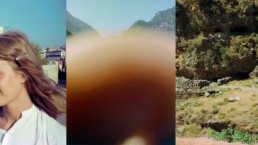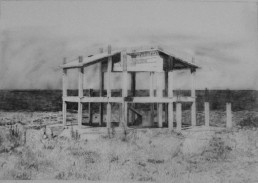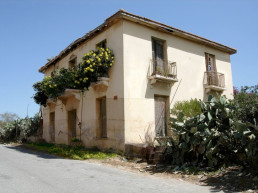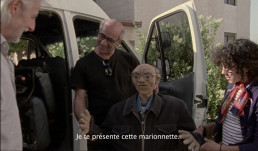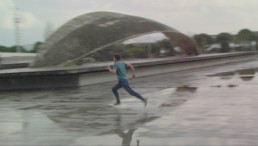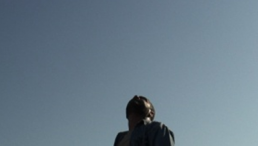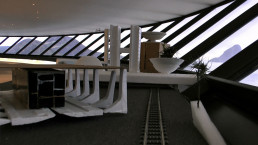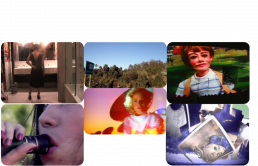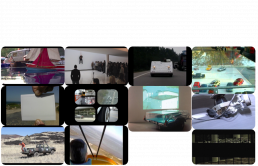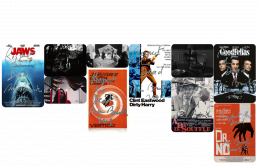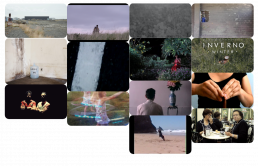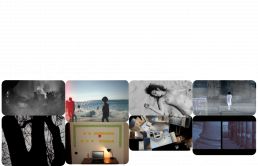28 Agosto, 22h
Museu Nacional de História Natural e da Ciência
Suspended Spaces
Curadoria de Françoise Parfait
Duração da sessão 68’
O projeto Suspended Spaces, inaugurado em 2007, é um projeto coletivo e itinerante, que faz escalas em sítios geopolíticos onde a modernidade deixou objetos inacabados. No Chipre, Líbano e atualmente no Brasil os artistas questionam os espaços que estão à espera de “resoluções” políticas, económicas ou poéticas.
Sophie Ristelhueber, Over There, 2010, 5’
«Em Julho de 1974, de férias em Creta, tenho 24 anos e encontro-me, pela primeira vez, com a guerra.
No sul da ilha, avisos de mobilização geral são afixados um pouco por todo o lado, nas paredes, nas árvores, nas praças das aldeias. A ilha esvazia-se de súbito com a partida dos seus homens, que eu vejo subir para os autocarros, partindo para o Chipre, para a guerra.
Ao refletir no projeto Suspended Spaces, pensei nas fotos recordando essa viagem. Elas são imperfeitas, mal enquadradas, com um caráter de estranheza devido aos dedos que, às vezes, se veem diante da objetiva. Embora nunca tenha ido ao Chipre, percebo que esta ilha e Creta são geograficamente muito semelhantes, quais gémeas: latitude, superfície, população, paisagens.
O acaso colocou-me num cruzamento da minha história pessoal e com um momento da história, ainda inacabado ‘over here’.» Sophie Ristelhueber
Jan Kopp, The House, 2009, 4’42’’
Para realizar a animação The House, Jan Koop redesenhou uma fotografia que tirou a uma construção em betão armado na parte norte do Chipre. Esta construção inacabada, restos de uma obra por terminar, era igual não só às que existem às centenas na ilha, mas também noutros locais da bacia Mediterrânea, sem que se saibam as razões deste estado de coisas (talvez problemas legais, financeiros ou políticos). Jan Koop interessou-se particularmente por esta construção inacabada “pela sua arquitetura que lembrava a silhueta dum templo da Grécia Antiga”.
Françoise Parfait, Botanica entropica, 2009, 4’
“Primeira visita: A atração que sinto por esta casa e pela sua beleza é como a que permanece em nós quando recordamos modelos perfeitos guardados na infância – a morada de família, casa quadrada e opulenta dos avós onde se passavam as férias no campo – mas rapidamente perdida. Um movimento contrário, uma espécie de calafrio difuso que não compreendi de imediato impôs-se pouco a pouco: havia qualquer coisa que não funcionava, uma espécie de desproporção, de anacronismo, de incongruência, nas flores orgulhosas e eretas, com amarelos demasiado verdes, com dimensões exageradas para a pequena varanda onde estavam colocadas…” Famagusta, Chipre.
Ziad Antar, Famagusta, 2009, 1’
Por ocasião de um almoço numa pequena taberna de uma aldeiazinha Cipriota, perto de um lugarejo muçulmano abandonado desde a divisão de 1974, Ziad Antar deu conta de um pequeno cartaz humorístico afixado nas casas de banho, no qual se via a silhueta de dois burros. Estavam atados um ao outro, mas cada um puxava em sentido contrário para alcançar as folhas dos arbustos que estavam diante deles. Depois de cada um ter tentado em vão ser o mais forte, os dois burros param, esgotados, sentam-se e olham um para o outro enquanto um ponto de interrogação sublinha o seu desalento. Então decidem os dois ir comer o mesmo arbusto.
Mira Sanders, The Journey, 2009, 5’
The Journey propõe uma viagem através da história e iconografia do turismo.
Este trabalho tem como ponto de partida a viagem de Mira Sanders em 2008 ao Chipre, onde sentiu a ambivalência do turismo: a tensão emanada da ilha, que é ao mesmo tempo um lugar de repouso privilegiado dos turistas ocidentais.
Mira Sanders encontrou essas imagens no decurso de pesquisas sobre o turismo e a sua evolução. Ela cortou-as e montou-as entre elas e redesenhou umas tantas. De seguida juntou-as numa grande maquete que a câmara visita. Os grandes imóveis do vídeo fazem lembrar os complexos turísticos construídos nos anos de 1960 e deixam entrever, através das suas janelas imagens de locais turísticos. O visitante reconhece um grande número desses clichés, porque eles fazem parte do nosso imaginário coletivo. Essas paisagens e monumentos estão classificados de acordo com a sua natureza e o conjunto, sob o telhado do grande projeto da biblioteca do arquiteto Etienne-Louis Boullée (1786), propõe um arquivo internacional de turismo. Diante dos edifícios, apercebemo-nos da multidão humana que percorreu o mundo desde há séculos.
Esta interrogação sobre as imagens e sobre a representação do espaço forma o conjunto da obra de Mira Sanders, que ela própria define com o título Jornal de um utilizador do espaço, expressão inspirada pelo ltítulo do livro Espèces d’espaces, de George Perec.
Valérie Jouve, Traversée, 2012, 18’
Da Palestina sabemos as complexidades territoriais complicadas, deslocar-se é em si mesmo uma questão política escaldante. Valérie Jouve decidiu aí filmar um road movie de Jerusalém a Nablus, onde seguimos uma marionetista acompanhada do seu boneco de trapos mudo e de uma jovem adolescente, que mantêm uma relação harmoniosa. As paisagens são descobertas pelos travellings a partir da sua carrinha, que possibilitam vislumbrar as cidades, colinas e o muro que separa o espaço – e os seus encontros. Uma falsa fluidez, pontuada por imagens fixas, faz das fotografias estampidos que pontuam o filme. (N. Féodoroff)
«A travessia do território é ditada por um peculiar e improvável trio: uma criança, uma marionetista e o seu fantoche, e o seu duplo pobremente identificado (como um elemento criando laços). As suas relações são afetuosas, mas tumultuosas. Estas duas personagens não são os protagonistas do filme, mas mais mensageiros deste território. Eles põem as relações humanas em jogo, extraídas de uma simples leitura de conflito, para restaurar outra realidade de vida lá.»
Jan Kopp, Courir Niemeyer, 2013, 3’42’’
Vídeo realizado a partir das captações em vídeo de diversos artistas (Maïder Fortuné, Nesrine Khodr, Marcel Dinahet, entre outros), que participaram da primavera de 2012 na etapa libanesa do projeto Suspended Spaces. No vídeo, Jan Kopp aparece a correr sobre o local da Feira Internacional Rachid Karamé do arquiteto Niemeyer, em Tripoli, Líbano, e que ficou inacabada. A corrida parece uma veia que se escapou no espaço e no tempo. O artista aparece numa escala minúscula no meio deste quadro arquitetural desértico, símbolo do modernismo e de uma idade de ouro do passado. “O meu corpo aqui é efetivamente um instrumento que me permite talvez medir este lugar, tornando-se o instrumento que mostra esse lugar”. A monumentalidade do quadro imóvel contrasta com a fragilidade do corpo em movimento, e mais ainda, com o contexto político e económico do país.
Daniel Lê, The Sky Over Saïda, 2013, 8’43’’
No sul do Líbano, na cidade de Saïda, testemunhei um curioso ballet aéreo de pombos. Todas as manhãs e todas as noites antes do pôr do sol, no topo de um telhado, um homem coloca uma bandeira de um partido político de esquerda de Saïda e os pombos voam. Os pássaros voam em círculo. O círculo que eles traçam no céu sobre a cidade expande-se gradualmente. Ibrahim senta-se, olha para o céu e segue este voo silencioso.
Saïda é uma cidade do sul do Líbano e podemos imaginar Ibrahim a olhar para outros objetos que voam no céu. Eventualmente, noutro telhado, outros pombos partem e também traçam um círculo cada vez maior até que os dois círculos se encontram. É uma antiga tradição do Médio Oriente colocar os pombos a voar em círculos e tentar trazer de volta os pombos de outra pessoa ao seu telhado. Os jogadores guiam os pombos atirando ao ar, com a ajuda de uma fisga, limões, pequenas pedras ou mesmo cebolas. Ibrahim comunica com os seus pombos por assobio. De seguida, ele dobra a sua bandeira, e é o sinal para os pombos voltarem a casa.
Marcel Dinahet, Sur les toits – Tripoli/Niterói, 2013-2014, 3’
Corre em cima dos telhados de construções circulares de Oscar Niemeyer em Trípoli, sobre a cúpula, e em Niterói sobre a plataforma do telhado, possibilitando uma visão 360º do espaço envolvente onde se inscrevem estas realizações arquiteturais. Em simultâneo, a perceção deste espaço envolvente e da dimensão física do edifício mantém-se durante o tempo de uma rotação.
Maïder Fortuné, It’s All True (pour un projet de film), 2014, 10’
Na baía do Rio, erra o fantasma de um crocodilo.
Diz-se que vem do Nordeste.
Que foi devorado por um tubarão depois de ter encontrado o presidente Vargas.
Diz-se que é por causa de um filme realizado por um americano.
Diz-se também que os tubarões não comem crocodilos.
E que Orson Welles não tem nada que fazer lá dentro.
No quadro de uma residência no Museu de Arte Contemporânea de Niterói, com o coletivo Suspended Spaces.
Eric Valette, Boa Viagem, 2014, 5’
Boa Viagem inscreve-se na série de vídeos Love Train. Foi inteiramente rodada na MAC-Niteroi (arquitetura de Oscar Niemeyer), na baía do Rio de Janeiro.
Uma câmara montada num comboio elétrico atravessa paisagens arquiteturais que serpenteiam e parecem construir-se à medida que o comboio avança. Cada sequência termina pelo embate com a maquete do parlamento de Brasília, e prende-se a um outro percurso.
As maquetes e as filmagens foram realizadas com a colaboração de estudantes do curso de Artes da Universidade Federal Fluminense (Brasil): Gabriela Bandeira, Filipe Brito, Shirley Cunha, Elisa Gouvea, Barbara Perobelli, Juliana Rodrigues, Bruno Torres, Mateus William.
August 28, 10pm
Museu Nacional de História Natural e da Ciência
Suspended Spaces
Curatorship by Françoise ParfaitTotal running time 68’
The Suspended Spaces program, founded in 2007, is a collective, traveling project, which stops in geopolitical places where modernity has left incomplete objects. In Cyprus, Lebanon and now in Brazil, the artists question spaces in anticipation of political, economic or poetic “resolutions”.
Sophie Ristelhueber, Over There, 2010, 5’
«In July 1974, on holidays in Crete, I am twenty-four years old and this is my first encounter with the war.
At the island’s south, general mobilization notices are posted everywhere, on walls and trees in the village squares. The island suddenly emptied of its men, I see them getting on the buses, they leave for Cyprus to war.
Thinking about the Suspended Spaces project, I thought of the photos from this trip. They are clumsy, poorly framed; they have certain strangeness due to fingers occasionally and accidentally caught on the lens. Although I never visited Cyprus, I discover that this island and Crete are geographically very similar, like twins: latitude, area, population, landscapes.
Chance placed me at the crossroads of my personal history and a moment in history, still unfinished, ‘over there’. » Sophie Ristelhueber
Jan Kopp, The House, 2009, 4’42’’
To make the animation film The House, Jan Kopp redrew a photograph he took of a reinforced concrete building in the northern part of Cyprus. This construction is unfinished, residue of an incomplete construction site of which there are hundreds on the island and elsewhere in the Mediterranean. A situation for which we don’t know the reasons (legal problems, financial, or maybe political). Jan Kopp was particularly interested in the unfinished building “for its architecture reminiscent of the silhouette from a temple in ancient Greece.”
Françoise Parfait, Botanica entropica, 2009, 4’
“First visit: My attraction to this house and its beauty recalls patterns encrusted in childhood – holiday at the grandparents’ opulent family holiday house in the country – this attraction has quickly dissipated. A counter movement, a kind of diffuse fear that I did not understand immediately took over little by little: there was something wrong, a kind of disproportion, anachronism, incongruity in these proud and erect flowers, with yellows too green, too large for the balcony on which they were placed…” Famagusta, Cyprus.
Ziad Antar, Famagusta, 2009, 1’
On the occasion of a luncheon in a small tavern of a small Cypriot village, not far from a Muslim hamlet abandoned since the 1974 partition, Ziad Antar noticed a humorous poster hanging in the toilet. It shows two donkeys drawn in silhouette. They were tied up to each other but were pulling in opposite directions, trying to reach the leaves of bushes located in front of each of them. After both trying in vain to be the strongest one, the two donkeys stop, exhausted, and sit down with a question mark above underlining their dismay. They then decide to graze the same bush.
Mira Sanders, The Journey, 2009, 5’
The Journey offers a voyage through the history and iconography of tourism.
This work has as its starting point the journey taken by Mira Sanders in 2008 in Cyprus, where she felt the ambivalence of tourism: the island exuded tension, and yet was a place of relaxation for Western tourists.
Mira Sanders found the images she used in the film during research about tourism and its evolution. She cut them, mounted them and in some cases redrawn them. She then assembled them into a large model that the camera visits. The large buildings in the video are reminiscent of the big hotel complexes built in the 1960s. Tourists’ sites can be glimpsed through their windows. Visitors recognize many of these pictures, because they are part of our collective imagery. These landscapes and monuments are classified according to their nature, and the whole under the roof of the large library project of the architect Etienne-Louis Boullée (1786), offer an international tourism archive. In front of the buildings, we see the crowds of people who have traveled the world for centuries.
This questioning of the images and the representation of space pertains to the whole work of Mira Sanders, a work she defines by the title Diary of a space user, inspired by a title of a book by Georges Perec, Species of Space.
Valérie Jouve, Traversée, 2012, 18’
Of Palestine we know acute territorial complexities. Going there in itself poses a burning political question. Valérie Jouve decides to film a road movie there: from Jerusalem to Nablus, we follow a puppeteer accompanied by his mute cloth puppet double and a young teenager girl, and witness their playful relationship. The landscapes, revealed by traveling shots from their van, will be showing cities, hills, and the wall, blocking the space. And their meetings. A false fluidity, disturbed by still images, actually photographs that punctuate the film. (N. Féodoroff)
«The crossing of the territory is dictated by a quirky and improbable trio: a child, a puppeteer and his puppet, and his poorly-identified double (as an element creating ties). Their relationship is tender, but tumultuous. These two characters are not the protagonists of the film, but more couriers of this territory. They bring the human relationships back into play, extracted from a simple reading of the conflict, to restore another reality of life there.»
Jan Kopp, Courir Niemeyer, 2013, 3’42’’
A video made from video recordings of several artists (Maïder Fortuné, Nesrine Khodr, Marcel Dinahet, among others) who participated in the spring of 2012 in the Lebanese stage of the Suspended Spaces project. In the video, Jan Kopp appears running at the unfinished site of the Rashid Karami International Fair designed by the Brazilian architect Oscar Niemeyer, in Tripoli, Lebanon, and which was never finished. The race seems like a vein escape in time and space. The artist appears as a small figure in the middle of this immense deserted architectural framework, a symbol of modernism and of a past golden age. “My body is here, in fact, an instrument that might allow me to take the measure of this place while becoming the instrument showing this place.” The monumentality of the frozen frame contrasts with the fragility of the body in motion and, more broadly, with the political and economic context of the country.
Daniel Lê, The Sky Over Saïda, 2013, 8’43’’
In southern Lebanon, in the town of Saïda, I witnessed a curious aerial pigeon ballet. Every morning and evening before sunset, on a roof top, a man puts up a flag from a left-wing political party of Saïda and pigeons fly around it. The birds fly in a circle. The circle that they trace in the sky over the city expands gradually. Ibrahim sits, looks up at the sky and follows this silent flight.
Saïda is a town of south Lebanon and we can imagine Ibrahim looking at other objects flying in the sky. Eventually, on another rooftop, pigeons depart and also describe a circle increasingly wider until the two circles meet. It is an old middle-east tradition to make pigeons fly in circles and try to bring back to one’s rooftop the pigeons of somebody else. The players guide the pigeons by throwing in the air, with the help of a sling, lemons, small stones or even onions. Ibrahim communicates with his pigeons by whistling. Then he folds his flag, it is the signal for pigeons to come home.
Marcel Dinahet, Sur les toits – Tripoli/Niterói, 2013-2014, 3’
Runs by the top of Oscar Niemeyer’s circular roofs over the dome in Tripoli, and in Niterói on the roof platform, allowing a 360º view of the surrounding space where these architectural achievements are inscribed. At the same time, the perception of this surrounding space and the physical dimension of the building is maintained during the time of a rotation.
Maïder Fortuné, It’s All True (pour un projet de film), 2014, 10’
In the Bay of Rio, lurks the ghost of a crocodile.
They say it came from the Northeast.
That it was devoured by a shark after meeting President Vargas.
They say it is because of a film made by an American.
It is also said that sharks do not eat crocodiles.
And that Orson Welles has nothing to do with it.
As part of a residence at the Museum of Contemporary Art in Niteroi, with the Suspended Spaces collective.
Eric Valette, Boa Viagem, 2014, 5’
Boa Viagem is part of the Love Train video series. It was entirely shot at MAC-Niteroi (designed by Oscar Niemeyer), by the bay of Rio de Janeiro.
A camera placed on an electric train crosses the meandered architectural landscapes that seem to be building as the it passes by. Each sequence ends with a striking of the model of the parliament in Brasilia, and moves on to another course.
Both models and shooting were done in collaboration with students of the Artistic course of Universidade Federal Fluminense (Brazil): Gabriela Bandeira, Filipe Britto, Shirley Cunha, Elisa Gouvea, Barbara Perobelli, Juliane Rodrigues, Bruno Torres, Mateus William.
